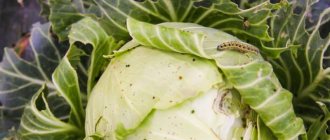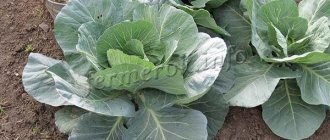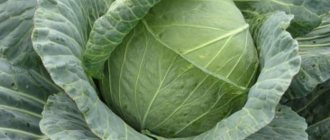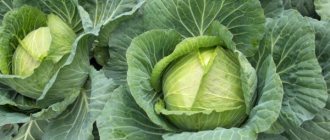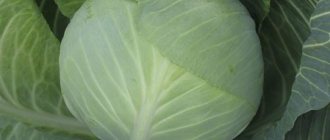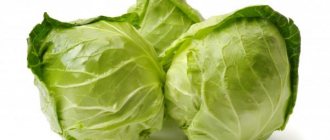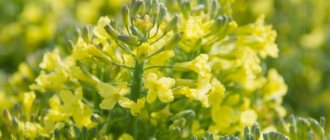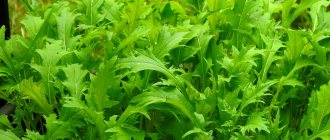Rinda is a hybrid cabbage variety that is popular among gardeners due to its high yields, excellent taste and the ability to be transported without losing its presentation. It bears fruit in round-spherical heads of cabbage, each weighing 3-7 kg, delicate dark green color, thin leaves and a short stalk. Cabbage has a universal purpose and can therefore be consumed fresh or processed.
Rinda cabbage seeds
The Rinda variety is unpretentious
Rinda cabbage harvest
Breeding history
Rinda F1 is a hybrid of white cabbage (Brassica oleracea var. capitata) of medium maturity. It was bred by Dutch breeders of the agricultural company Seminis Vegetable Seeds. Until 2005, the company was one of the largest producers and growers in the world with a market share of more than 20%. The company's main products are hybrid seeds of fruits and vegetables.
In 2005, Seminis became part of a larger entity, the Monsanto Company. This company, headquartered in the US state of Missouri, became famous as the manufacturer of the world-famous herbicide Roundup.
In 1993, Rinda was included in the State Register of the Russian Federation for cultivation in two regions - Central and Vyatka. When grown in other areas, it may not show all its positive qualities.
Advantages and disadvantages of the variety
The characteristics of a variety include its positive and negative qualities. The advantages of Rinda cabbage are:
- excellent sweet taste and juicy pulp;
- high yield rates;
- long-lasting presentation, good keeping quality and simultaneous ripening of heads of the same size;
- unpretentiousness to growing conditions and soil composition;
- easily adapts to temperature differences;
- high resistance against typical diseases.
The disadvantages of this cabbage hybrid are as follows:
- there is no resistance to long periods without water, as well as to stagnation of moisture;
- increased need for insolation; if there is a lack of it, the heads of cabbage may not set;
- may be affected by slugs and fleas;
- Due to its popularity, there is a risk of purchasing fake seed material.
The main feature of mid-season Rinda cabbage is its unpretentiousness in care, as well as good yield, which makes it suitable for cultivation in various climatic zones of Russia. This guarantees Rinda well-deserved popularity among gardeners, despite the huge selection of white cabbage on the market.
Description of Rinda F1
The hybrid is suitable for growing in open ground in spring-summer and summer-autumn. Let's take a closer look at what kind of harvest it brings.
Appearance
To describe the appearance of heads of cabbage, attention should be paid to the following characteristics:
- weight - on average 3-7 kg, but sometimes gardeners manage to obtain specimens weighing up to 8-10 kg;
- shape – round-spherical;
- color – light green, fairly uniform, and when cut the color is yellow-white;
- leaves are juicy and tender, but at the same time dense and elastic, with thin veins;
- outer stalk – short;
- The rosette is compact, half raised, medium spreading, with a beautiful internal structure.
The variety has strong growth and a compact, uniform size, and compares favorably with its counterparts in its high resistance to cracking when fully ripe.
You can clearly see what the Rinda F1 cabbage variety is in the following video:
General characteristics
The key characteristics of the hybrid can be found below:
| Parameter | Description |
| Ripening period | Rinda belongs to the mid-season hybrids, therefore it ripens 75-85 days after the appearance of the first shoots. In general, the period from sowing to technical ripeness of cabbage is 120-130 days. |
| Productivity | The variety is very productive, since from 1 sq. m of plot you can get 10 kg of heads of cabbage, and from 1 hectare - up to 900-115 c. Their ripening is uniform, which greatly simplifies the harvesting process. |
| Features of cultivation | The plant is unpretentious, tolerates temperature changes, grows in different climatic conditions and is undemanding to the condition of the soil. In addition, Rinda is resistant to diseases and pests. |
| Ease | Heads of cabbage can be stored on the root for a long time, but the harvested crop can be kept for up to 4-5 months. However, some gardeners note that if the optimal temperature and humidity conditions are maintained, cabbage will be stored without affecting its appearance and appearance until April. |
| Transportability | Representatives of this variety tolerate transportation well over long distances, without loss of appearance and taste. In this regard, Rinda is suitable for cultivation for the purpose of sale on the market. |
| Purpose | Cabbage is suitable for fresh consumption and preparation of culinary dishes, especially cabbage rolls, since the thin and elastic leaves do not break during the cooking process, and the dish turns out excellent. Cabbage can also be pickled and fermented. |
The best way to process cabbage of this variety is pickling, as it turns out juicy and tasty. However, it must be fermented fresh, and not several months after storage in the cellar, since in this case the amount of juice released will be small, and the sauerkraut will turn out tasteless.
Reviews from gardeners
There are only positive reviews on the Internet about Rinda F1 cabbage. All gardeners love it. However, see for yourself:
Alevtina Petrovna, Svetlovodsk
Rinda cabbage came to me by accident. A neighbor shared the seeds. This was about 5 years ago. Now I only grow this variety. It rises beautifully. It grows wonderfully and stores well. At the same time, her heads are always perfect. Perfectly even, one size. Really like. I advise everyone.
Igor, Moscow region
I have been growing Rinda for a long time. I purchased it on purpose. I was looking for an inexpensive hybrid with friendly ripening, and the seller recommended Rindu. I plant about 40 acres with it and always harvest from 30 to 40 tons of harvest. Can be harvested mechanically. Cabbage is also good for transportation. Looks appetizing and tastes good. Therefore, I already have regular customers who specifically wait for the ripening of this particular hybrid for the starter.
Leontia, Omsk
This year I grew Rinda F1 for the first time. I fell for the description and didn’t regret it. Even with our short summer, the cabbage managed to ripen. Some forks grew up to 4.5 kg. But the bulk is about 2.5-3.5 kg. Let's see how it will be stored. So far it is laying well and the leaves are not turning brown. But it only lasts 1.5 months. The taste is pleasant: juicy and sweet. I’ll probably set aside a place on the plot for this variety next year.
Agricultural technology
To get a good early harvest, the following agrotechnical rules should be taken into account when growing Rinda:
- There are two ways to grow cabbage: seedlings or direct sowing into the ground. Planting work should be carried out from late April to mid-May.
- Cultivate the vegetable in well-lit and windless areas, since a lack of light will negatively affect yields. In addition, lowland and elevated places are undesirable for this culture, since it does not tolerate moisture stagnation or its lack. It is desirable that groundwater be located at a level of 1-1.5 m from the surface.
The area where cabbage is grown should be illuminated by sunlight from morning to evening, and there should be no shadow from neighboring trees, bushes, fences or tall crops. The fact is that in the shade Rinda will not set heads of cabbage, but will only produce a lush rosette of leaves.
- When choosing a site, follow the rules of crop rotation. Cabbage can be planted in its original place only after 3-4 years. In addition, tomatoes, beets, turnips, mustard, watercress, radishes and radishes are bad precursors of the crop. As for the best predecessors, these include: cereals;
- legumes (beans, peas);
- potato;
- eggplant;
- zucchini;
- squash;
- pumpkin;
- cucumbers;
- carrot;
- turnip;
- garlic;
- onion.
If soil fertility is maintained every year, the dose of mineral fertilizers can be reduced by 2 times, since cabbage does not absorb them well and even accumulates harmful nitrates. When using organic matter, you can completely abandon mineral fertilizers.
Plant at moderate density, and then provide the plant with regular watering and loosening. It is equally important to adhere to all preventive measures to protect it from cabbage diseases and pests.
Seed preparation
If the seeds are not brightly colored and have not been processed by the manufacturer, they will have to be disinfected yourself, regardless of the method of growing cabbage. To do this you need to do the following:
- Select viable specimens. To do this, pour the seeds with a salt solution (40 g per 10 liters of water). Those that float to the surface should be discarded as they are either empty or damaged.
- Calibrate the seeds remaining at the bottom, that is, select among them medium and large specimens measuring 1.5-2.5 m.
- Soak the selected material in hot water (50°C) for 20 minutes and in cold water for 5 minutes. Next, place the seeds on a towel and dry. To speed up germination, they can be soaked in water at room temperature for 12 hours, but it will have to be changed every 4 hours. To harden, soaked seeds should be kept cool for a day (+1-2°C), for example, on the bottom shelf in the refrigerator. After this, they need to be dried to eliminate stickiness.
To increase germination, seeds can be additionally treated in a solution of humates or EM preparations.
How to plant without seedlings?
This method of growing cabbage is optimal if all the necessary conditions for preparing seedlings are not available. If you keep it in the shade or in a poorly heated room, it will stretch out greatly, and when transplanted to a permanent place it will get sick. So, in this case, it is more advisable to sow the seeds directly into open ground.
Planting activities are carried out in the spring, when the soil becomes wet after rains. The most favorable period is the end of April - beginning of May.
If you sow in May, the heads of Rinda will reach technical ripeness already at the end of August - beginning of September.
Prepared seeds should be sown in open ground in the following sequence:
- Prepare small holes 2-3 deep with an interval of 25-30 cm. The optimal distance between rows is 80-100 cm.
- Moisten the furrows with water so that the soil is moist to a depth of 20 cm.
- Throw 3-5 seeds into each hole and sprinkle with the remaining soil (you can use sawdust or humus).
- Cover each hole with a plastic bottle with the bottom cut off, trying to insert it deeper into the ground. To ventilate, the bottle cap must be unscrewed for several hours every day. When the first shoots appear, it needs to be removed completely. The greenhouse can be removed only after the threat of frost has completely passed and the plant has grown and begins to touch the walls of the bottle.
- When several shoots appear in each hole, leave one of the strongest and strongest sprouts 15 cm long, and pinch off the rest or carefully cut them with scissors. It is impossible to pull out excess shoots, since this can damage the fragile root system of the plant.
When grown without seedlings, the growing season will be shortened by 15-18 days, and the yield of cabbage will increase due to the formation of a powerful root system capable of drawing moisture from the deep layers of the soil.
Disease control methods
Cabbage variety Rinda is susceptible to some diseases. The most dangerous diseases and ways to combat them:
- Vascular bacteriosis. Signs: yellowing of foliage, black veins, rotting of the head. Treating the plant with Planriz will help with this. After 20 days it is carried out again.
- Cabbage mosaic. Symptoms are holes on the leaves and heads of cabbage, brown and black spots. In this case, the plant cannot be cured - it must be dug up with roots and burned.
- Blackleg. Manifestation: black rot that affects the stem of cabbage. The drug Granozan will correct the situation.
Cabbage affected by vascular bacteriosis
Important! Kila is considered another fatal disease.
Growing through seedlings
In Russian conditions, Rinda is often grown through seedlings. The timing of planting depends on the specific region, but often occurs at the beginning of April, since seed material must be planted 30-35 days before transplanting seedlings into open ground.
Preparing seedlings
Growing strong seedlings is carried out in several stages:
- Substrate preparation. A suitable soil mixture can be purchased at a garden center. It should be nutritious and light, with good ability to pass water and air. Of course, you can make the substrate yourself by combining the following ingredients:
- 1 part of turf land;
1 part perlite, sawdust, river sand for greater soil looseness;
- 2 parts humus, peat or vermicompost.
- Sowing . Pour the substrate into a container with drainage holes. This can be a wooden box or pallet, a cassette or individual cups measuring 5x5 cm. Make holes 1-1.5 cm deep on the surface of the soil, lay out the prepared seeds (2 seeds in each furrow), cover with soil and water. When planting in a common container, adhere to a 2x3 cm pattern. If all the seeds germinate in one hole, you need to leave only the strongest sprout, and pinch off the rest or cut it with scissors.
- Organization of optimal temperature conditions and lighting . Immediately after sowing, the air temperature in the room should be maintained at +20...+22°C. In addition, seedlings need to be provided with good lighting (12 hours a day) using lamps. When the first shoots appear, lower the air temperature in the room to +15...+17°C during the day and to +8...+10°C at night, otherwise the shoots will elongate excessively.
- Watering . It should be moderate but regular so that the soil does not dry out. At the same time, it should not be allowed to become waterlogged, otherwise the seedlings may get sick. In case of excessive moisture, it is better to loosen the soil superficially. The plant should also be watered before each feeding, otherwise the fragile roots of young seedlings may get burned.
- Picking . On the 14th day after planting, the seedlings should be planted in separate cups if the seeds were planted in a common container. Before transplanting, water each seedling generously.
- Top dressing. Seedlings need to be fed 3 times according to this scheme:
- a week after picking - fertilize with a solution prepared from 4 g of superphosphate, 2 g of potassium fertilizers and ammonium nitrate per 1 liter of water (a liter of this composition is enough to treat 50-60 seedlings);
- after another 2 weeks, feed the seedlings with the same composition, but with double the amount of ingredients per 1 liter of water;
- 2 days before planting in a permanent place, feed the seedlings with a composition for better rooting of sprouts, using a solution of 3 g of ammonium nitrate, 5 g of superphosphate and 8 g of potassium fertilizers per 1 liter of water.
- Hardening. Such manipulation will contribute to the survival of the plant in a new place and better development of roots. Carried out 10 days after transplantation. Initially, within 2 days in the room you need to open the windows for 3-4 hours. In the next few days, it is better to take the seedlings out onto the balcony or outside for 2 hours, but do not allow the sun to burn them. On days 6-8, the seedlings can be completely moved to an open balcony and the frequency of watering can be reduced.
Seedlings with 6-8 true leaves and a height of 15-20 cm can be transplanted to a permanent place.
It is worth adding wood ash to the composition at the rate of 10 tbsp. l. per 10 kg of soil. Ash will increase the antiseptic properties of the substrate, and also saturate it with macro- and microelements. The finished composition must be disinfected by keeping it in the freezer or heated oven for several minutes. You can simply pour it with a solution of Fitosporin, which has antiseptic properties.
The composition of fertilizers can be replaced with complex fertilizer in ready-made liquid form.
Transplantation into open ground
Seedlings at the age of 30-45 days can be transplanted into open ground. As a rule, this period occurs at the end of May - mid-June. The work is carried out on a cloudy rainy day, in the morning or evening, so that the plant is not damaged by the sun.
Holes in the garden bed should be placed every 30-40 cm, so that per 1 sq. m there were no more than 3-4 plants. If planted more densely, Rinda will not be able to fully develop.
In each hole you should throw a handful of peat and sand, 2 handfuls of humus and wood ash. Transfer the seedlings into the holes together with a ball of earth so that the roots are not damaged. Next, sprinkle them with soil, compact them slightly and water them generously.
It is advisable to mulch the ground under the seedlings with peat or rotted sawdust to prevent moisture loss. If the weather is sunny, then during the first few days the seedlings need to be shaded so that they take root better.
Landing Features
To get a rich harvest of Rinda cabbage, you must follow the planting rules, which will determine the quality and taste of the fresh vegetable, as well as the preservation of beneficial properties in the event of further processing.
Basic nuances of planting Rinda cabbage
Despite the fact that cabbage is planted in the spring, the site should be prepared in the autumn. To do this, when digging, the soil is subjected to liming (0.5 kg/1 sq.m.) and flavored with organic fertilizers, adding 1 bucket of peat or humus per square meter. After planting, the area is watered and treated with herbicide - a chemical substance that prevents the proliferation of weeds. It is preferable to treat with Ramrod or Semeron according to the instructions (500–700 mg/1 sq. m).
Seedless growing method
For the seedless growing method, the preferred season is spring (if the soil is sufficiently moistened by heavy rains). When sowing, the distance between seeds should be 2.5–3 cm from each other, in row spacing - 8–10 cm.
The optimal sowing depth is considered to be 2–3 cm. Deeper planting negatively affects further germination.
6–7 seeds are placed in each hole, after which the soil must be mulched with horse humus or sawdust. Planting can be carried out using a square-cluster method using a 70x70 cm pattern.
At the end of April - beginning of May, you can sow cabbage seeds in open ground
Before planting the seeds, they must be calibrated in salt water (30 g salt / 1 liter of water) for 7-8 minutes, and then placed in hot water (45-50 ° C) for 30-40 minutes. This soaking prevents the development of pathogenic bacteria in the future.
Planting Rinda cabbage using the seedless method has its disadvantages:
- careful selection of the site and its preliminary preparation;
- careful care during the growing season and repeated control of weeds and pests.
Seedling growing method
To plant cabbage using seedling technology, you should prepare the soil in the fall. For this purpose, fall plowing (digging of soil in the autumn) and organic fertilizer are used.
Seedlings are grown in greenhouses using cubes and pots.
- Seeds, previously calibrated and soaked in hot water, are planted to a depth of 1–1.5 cm.
- Until the first shoots appear in the greenhouse, it is necessary to maintain a temperature of about +20–22°C.
- After the seeds germinate, the temperature should be lowered to +8–10°C.
- After 14 days, cabbage seedlings are transplanted to freer areas in order to improve their viability. This method of transplantation is called picking.
- Before transplanting, seedlings are watered abundantly.
- Final planting in open ground is carried out only after 6–8 leaves appear.
In order for cabbage seedlings to be strong and stocky, it is better to grow them with picking, then the seedlings will grow stockier and stronger, and it will be easier to transplant to a permanent place
Seedling care
The white cabbage hybrid is quite unpretentious in care, but requires timely implementation of all agrotechnical practices.
Watering
Rinda is moisture-loving, so seedlings need to be watered regularly and abundantly with settled warm water. If it is cold and from a hose, it can lead to the development of various diseases and slow down the growth of the plant.
Seedlings need to be watered in the evening every 3-4 days, adding per 1 square meter. m 8-10 liters of water. As the cabbage develops, the frequency of watering should be reduced to once every 7-9 days, but at the same time increasing the amount of water to 12-14 liters per 1 square meter. m. Stop watering completely 2 weeks before the heads of cabbage fully ripen.
Loosening and hilling
After each watering, the soil must be loosened to a depth of 8-10 cm so that a crust does not form on the surface of the soil. At the same time, it is also worth removing all weeds.
Cabbage also needs hilling, since this technique helps strengthen the stem and form roots, giving it additional strength. Hill up the cabbage on a windless day so that the new layer of soil is 25-30 cm high. During the entire growth period of the vegetable, carry out 2 hillings:
- for the first time - 10-15 days after planting in open ground;
- the second time - 45-40 days after the first hilling.
To maintain an optimal level of moisture in the soil, cabbage should be mulched (using peat, rotted sawdust or mowed grass). The optimal height of the mulch layer is 8-10 cm.
Top dressing
Cabbage is fed at the seedling stage. After transplanting to a permanent place, 2 more feedings are applied:
- At the stage of active leaf growth, water the plant with a solution of ammonium nitrate (20 g per 10 liters of water). Pour 0.5 liters of fertilizer under each bush.
- At the stage of head formation, carry out complex feeding by preparing a solution of 8 g of potassium sulfate, 10 g of superphosphate and 4 g of urea per bucket of water.
Protection from diseases and pests
Rinda is resistant to many diseases, but the following can still pose a threat to her:
- Black leg . The fungal disease affects the stem and root system of the plant, leading to slower growth and death. It manifests itself as black rot at the affected areas. Diseased specimens must be removed, since the black leg cannot be treated. In order to prevent it, seeds and soil must be disinfected, and crop rotation must be observed.
- Downy mildew (peronosporosis) . It appears as large gray or yellow spots on the leaves, which gradually dry out and die. At the seedling stage, diseased specimens can be sprayed with a 1% solution of Bordeaux mixture, Fitosporin or the fungicide Connoisseur.
- Kila . The fungus attacks the root system of the plant and leads to the formation of white growths that prevent the absorption of nutrients. As a result, the leaves turn yellow and wither, and the heads of cabbage turn out to be underdeveloped. Affected specimens must be destroyed by digging up a clod of earth. For preventative purposes, in the fall the area should be limed (200 g of lime per 1 sq. m), and in the spring the seedlings should be watered with a 3% solution of Bordeaux mixture.
- Mosaic of leaves . A common viral disease in which a mosaic network appears on the tops of the plant. At the same time, the leaves wrinkle, their edges darken and die. The disease cannot be treated, and damaged heads of cabbage cannot be eaten, so they will have to be destroyed. For prevention purposes, it is necessary to promptly remove weeds and destroy insects that carry the mosaic virus. These are mites and aphids.
Unfortunately, the hybrid may be attacked by pests such as:
- Aphid . It sucks out all the juices and nutrients from cabbage, causing the leaves to become deformed, curl and dry out. Aphids resemble ash and primarily live on the back of leaves. Affected specimens must be treated with an insecticide or a solution of laundry soap (40 g per 10 liters of water). Among the folk remedies, tinctures of tobacco, potato or tomato tops will help.
- Sacral flea beetle . It attacks the plant in early spring, gnawing holes on the tops, which leads to drying and death of young shoots. In the fight against fleas, pollination with a mixture of ash and tobacco in a ratio of 1 to 1 (30 g per 1 sq. m) will help. It is necessary to carry out 3-4 treatments at intervals of a week.
- Leaf beetle . These are beetles that settle on the leaves, suck out the nutritious juices from them, leading to the drying out and death of the plant. In the fight against leaf beetles, it is necessary to carry out pollination with a mixture of tobacco and ash (20-40 g per 1 sq. m), as well as spraying the plant with a solution of the Actellik insecticide (20 ml per 10 liters of water).
- Scoop . A voracious caterpillar that gnaws the head of cabbage to the center. Affected specimens must be destroyed as they are not suitable for consumption or storage. At the first sign of the appearance of caterpillars, the plant should be treated with an insecticide.
- Cruciferous bug . A beetle with a black pattern on a yellow or red background that gnaws through leaves and leaves equally dangerous larvae. Leads to weakening and gradual death of leaves. When pests appear, the planting must be treated with an insecticide.
To protect cabbage from the invasion of the listed pests, you need to promptly remove and destroy the remains of cabbage stalks after harvesting, weed the weeds and carefully dig up the area in the fall. In addition, the cabbage should be watered with water from a watering can and dusted with ash, tobacco or shag.
If cabbage is affected by pests, a new broad-spectrum biological product, Fitoverm, can be used against them. During the growing season, the plant should be sprayed 2 times with a solution prepared from 4 ml of the drug per 1 liter of water. Vegetables processed in this way can be eaten after just 2 days.
Diseases and pests of Rinda cabbage
Although the variety is disease-resistant, improper care often leads to trouble. Rinda may develop poorly and become ill with widespread cabbage diseases if:
- do not observe crop rotation;
- do not remove roots and leaves from old cabbage in the fall, the disease will certainly settle on such remains, and then spread throughout the entire area on the soles of shoes;
- do not weed, weeds attract pests and create a favorable microclimate for fungi and viruses;
- do not break the crust on the soil;
- do not comply with the norms and irrigation regime.
Cabbage diseases and treatment methods - table
| Disease | Signs | Treatment | Prevention methods |
| Kila | Clubroot develops on the roots in the form of swellings of various shapes. These growths grow, then collapse and infect the ground. Seedlings infected with clubroot die. If an adult plant gets sick, its leaves turn yellow, the head does not set or becomes loose. |
|
|
| Cabbage mosaic | Holes, brown and black spots appear on cabbage leaves and heads of cabbage. | Mosaic is difficult to treat. It is better to remove the diseased plant from the garden and burn it to protect the rest. | As a preventive measure it is recommended:
|
| Vascular bacteriosis | The leaves turn yellow, the veins turn black, and the head of cabbage, before it has time to grow, begins to rot. The disease continues to develop during storage. The virus is transmitted through plant debris in the soil, through seeds, and carried by insects. | At the first signs of illness, spray with Planriz solution, repeat after 20 days. |
|
The most common diseases of cabbage in the photo
Cabbage roots affected by clubroot. In the initial stage, the growths are not so obvious, they may be no larger than a bead
Covering leaves are covered with holes, black and brown spots
The leaves turn yellow and the vessels (veins) turn black. This is where the name of the disease comes from
Cabbage pests and ways to combat them - table
| Pest name | Description | Ways to fight |
| Cruciferous flea beetles | Small leaf beetles (2–4 mm in length) have an oval, convex shape. Color: black, blue, metallic green, with orange stripes. Individuals can jump like fleas and fly well. In a short period of time, pests can destroy young plantings and severely damage older ones. | Fleas do not like strong odors, so they are easy to fight without any chemicals. It is enough to dust wet cabbage leaves with a mixture of ash and tobacco (1/1) or pure tobacco or shag. You can water the cabbage by adding fir oil to the water (15 drops per 10 l). |
| White butterfly and cabbage scoop | These are different insects, but they cause the same harm: they lay eggs on the underside of cabbage leaves. Caterpillars emerge from them. At first they are inactive and stick together, then they spread and eat leaf by leaf, leaving only thick veins. | If you do not want to collect caterpillars by hand, cabbage is sprayed with the following preparations: Fury, Kemifos, Iskra-M. If you plant marigolds around the perimeter of the cabbage bed, they will scare away butterflies with their smell. |
| Cabbage fly | The pest looks like an ordinary fly. Flight begins during the flowering period of the birch, and when the cherry blossoms, the cabbage fly lays eggs in cracks in the soil near the cabbage stem. The emerging larvae gnaw through the stems, live and feed in them. The plant weakens and withers in hot weather. | During the summer, you need to sprinkle the cabbage stems with a mixture of ash and tobacco (1/1). Chemical method: 20 g of karbofos emulsion (30%) is diluted in 10 liters of water. Pour 0.5 liters of solution into each well. You can simply scoop the eggs off the cabbage. They are white and clearly visible. The newly born larvae will have nothing to eat and will die from exhaustion. |
| Slugs | These gastropods are very gluttonous; they love cabbage for its juiciness and frequent watering. During the day they hide in heads of cabbage or in any dark, warm and humid place. They are nocturnal. At the age of two months, eggs are laid under lumps of earth. | An insurmountable obstacle for slugs will be a groove dug around the entire perimeter of the bed with tobacco, ground hot pepper or ash at the bottom. There are also chemicals: Thunderstorm and Meta. |
Photo gallery: cabbage pests
Cabbage leaves infected with cruciferous flea beetles
Cruciferous flea beetle is a leaf beetle of black, metallic green or blue color, 2–4 mm long
Young caterpillars of the white butterfly are at first motionless, stick together, and then spread apart. They feed on the tender pulp on the underside of the leaf.
Owl caterpillar and butterfly. 2–3 generations grow per season
The pest looks like an ordinary fly
Slugs feed on succulent cabbage leaves and often crawl inside the head of cabbage.
Harvest and storage
The rapid ripening of Rinda cabbage occurs towards the end of August - beginning of September, when it is time to harvest. In dry weather, ripened heads of cabbage should be cut with a sharp knife and stored in a dark and cool place, for example, in a cellar or basement. The optimal storage temperature is from -1 to +2°C, and humidity is 80-85%.
The room needs to be ventilated 1-2 times a month so that the cabbage does not become moldy or turn yellow.
To store the heads of cabbage until the next planting, they can be placed either in canvas bags or in wooden or plastic boxes. In conditions of limited space, the heads can be hung by the stalks using twine or thick rope. The advantages of this method are that the cabbage rots less and is better preserved.
Heads of cabbage can also be stored on shelves, having previously been wrapped in sheets of paper to retain moisture. It is also advisable to dust them in order to protect them from early rotting.
Advantages and disadvantages
Rinda F1 is popular due to its following advantages:
- has high productivity (10 kg of heads of cabbage per 1 sq. m);
- is characterized by uniform ripening of the heads, which facilitates the harvesting process;
- unpretentious to weather conditions and soil conditions;
- rarely gets sick and is attacked by pests;
- tolerates transportation well over long distances (does not crack);
- brings sweet leaves that can be used for making salads, pickling and stewing.
The hybrid does not have any particular disadvantages, but you need to remember that this is a moisture-loving variety that does not tolerate prolonged drought. It cannot be cultivated at higher elevations, otherwise it will lack water. At the same time, low-lying areas, which are characterized by stagnant moisture, are also unfavorable. The variety also has an increased requirement for sunlight, since when grown in shaded areas its yield drops sharply.
Cabbage Rinda F1 is a hybrid with a ripening period of 75-85 days, which bears fruit abundantly in spherical heads weighing 3-7 kg. They can be stored for 4-5 months, used for processing or fresh consumption. Agricultural technology is simple, but to obtain a healthy and rich harvest it requires strict adherence to all the rules.
0
0
Copy link
Characteristics of the variety
Rinda - mid-season cabbage. It takes 100–110 days from germination to technical ripeness, and 70–80 days from planting in the ground. Productivity largely depends on weather conditions and quality of care. One head of cabbage can grow weighing both 3 kg and 8 kg. Russian gardeners managed to get 12 kg. Typical weight for Rinda is 4–6 kg.
Botanical features and purpose
Rinda's leaves are dark green with clearly visible light veins. The head of cabbage is dense, has a spherical shape, and is resistant to cracking. The stalk inside is short.
This variety is recommended to be used fresh and for pickling. When cut, cabbage is yellow-white. Rinda has an excellent taste, without bitterness.
Table: pros and cons of the Rinda variety
| Advantages | Flaws |
| High yield. | In the shade it may not set heads. |
| Resistance to cracking both in the garden and during transportation. | Like all cabbages, it is affected by slugs, cabbage bugs, and cruciferous flea beetles. |
| Great taste, no bitterness. | Due to the popularity of the variety, many fakes go on sale. |
| Short stalk. | |
| Undemanding in care. | |
| Resistance to common cabbage diseases. | |
| Universal purpose. |

